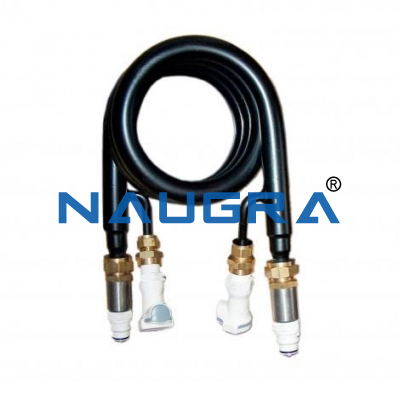- Workshop Tools and Workshop Machines India: buy@naugra.com

Coiled Concentric Tube Heat Exchanger .
Description of Coiled Concentric Tube Heat Exchanger for Science Lab Equipment Laboratory Instruments Manufacturers, Engineering Lab Equipments Manufacturers
An example of an industrial Coiled Concentric Tube Heat Exchanger with turbulence enhancing tubes. The heat exchanger is fully instrumented using the Heat Exchanger Service Unit with thermocouples on the inlet and outlet of both the hot and cold streams. The heat exchanger can be arranged so that either hot or cold streams are in the inner tube. With either configuration both co-current and counter-current flow can be established. The heat exchanger is deliberately not insulated so that heat losses in all of the configurations can be investigated.
Experimental Capability of Coiled Concentric Tube Heat Exchanger:
To determine the overall heat transfer coefficient for a shell and tube heat exchanger using the logarithmic mean temperature difference to perform the calculations
To investigate the effect of changes in hot fluid and cold fluid flow rate on the temperature efficiencies and overall heat transfer coefficient.
To investigate the effect of driving forces with counter-current and co-current flow.
Demonstration of indirect heating or cooling by transfer of heat from one fluid stream to another when separated by a solid wall.
Conducting an energy balance across a shell and tube exchanger and calculate the overall efficiency at different fluid flow rates
To demonstrate the differences between counter-current flow and co-current flows and the effect on heat transfer, temperature efficiencies and temperature profiles through a shell and tube heat exchanger.
Demonstration of indirect heating or cooling by transfer of heat from one fluid stream to another when separated by a solid wall
Specification of Coiled Concentric Tube Heat Exchanger:
Coiled Concentric Tube Heat Exchanger with turbulence enhancing tubes.
The heat exchanger is fully instrumented using the Heat Exchanger Service Unit with thermocouples on the inlet and outlet of both the hot and cold streams.
The heat exchanger can be arranged so that either hot or cold streams are in the inner tube. With either configuration both co-current and counter-current flow can be established.
The heat exchanger is deliberately not insulated so that heat losses in all of the configurations can be investigated
